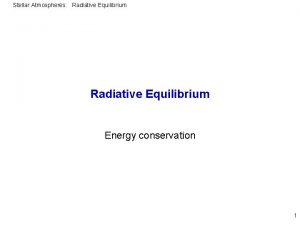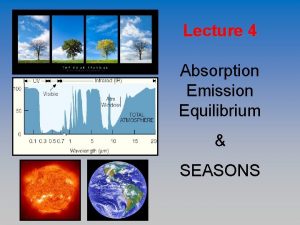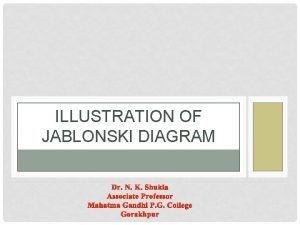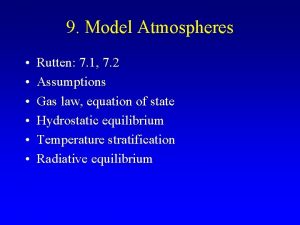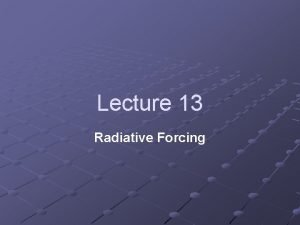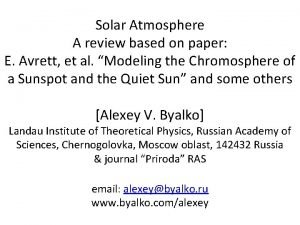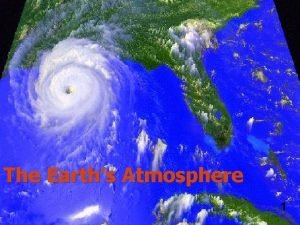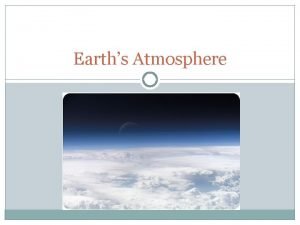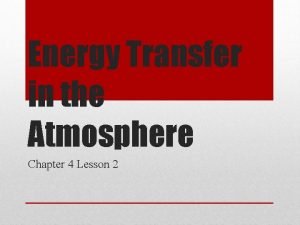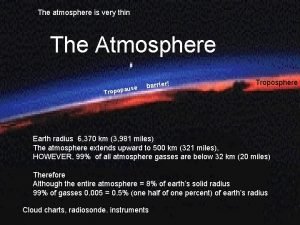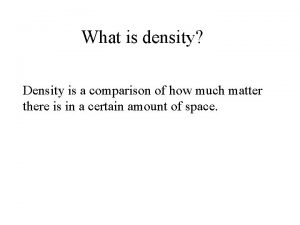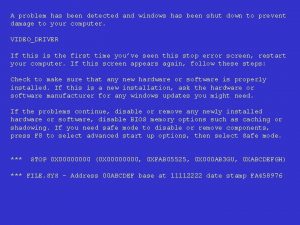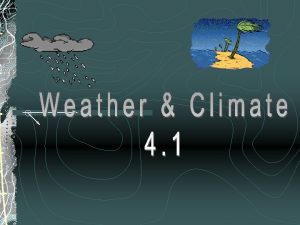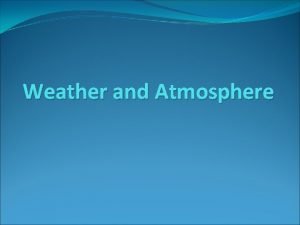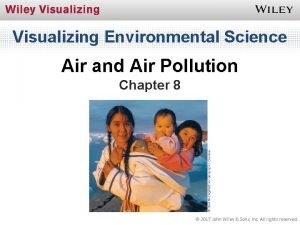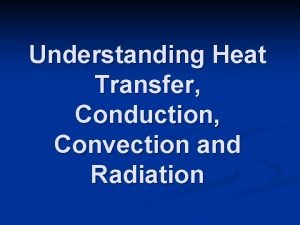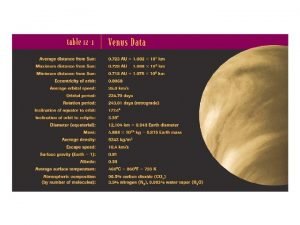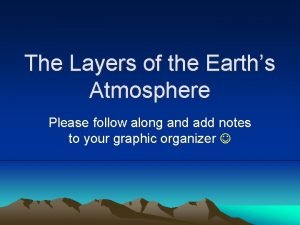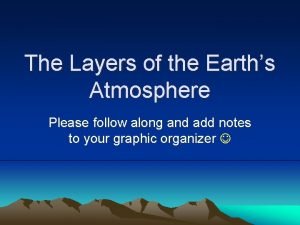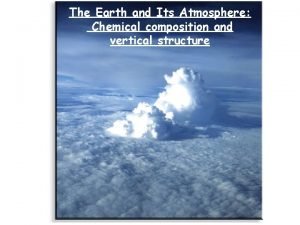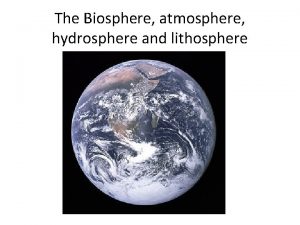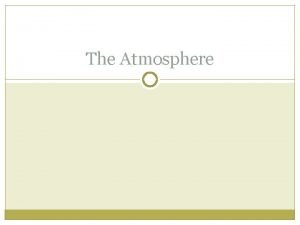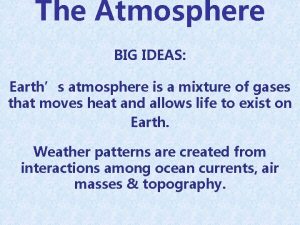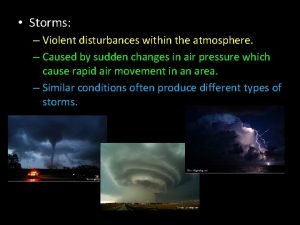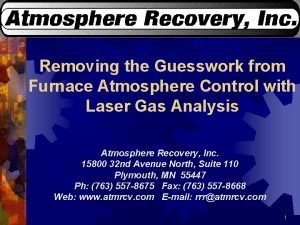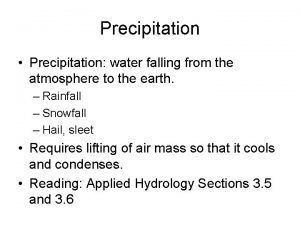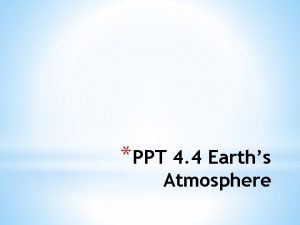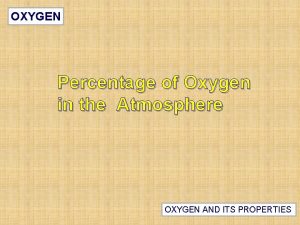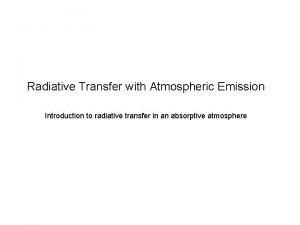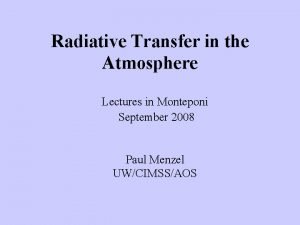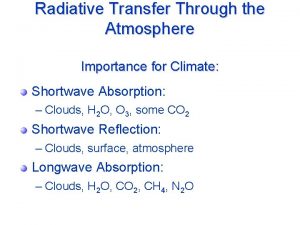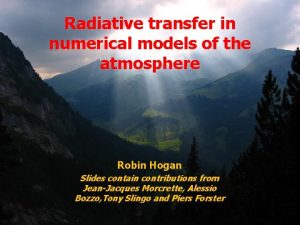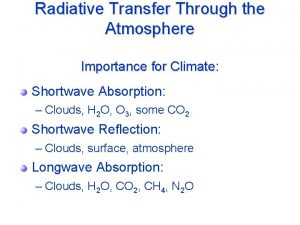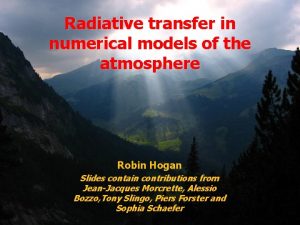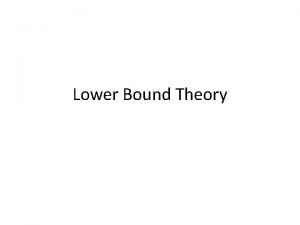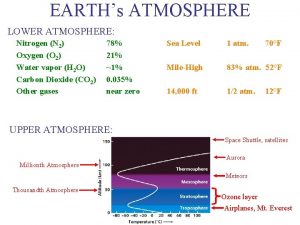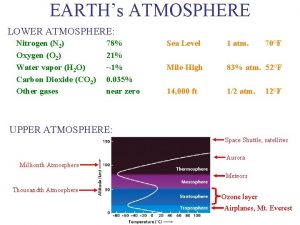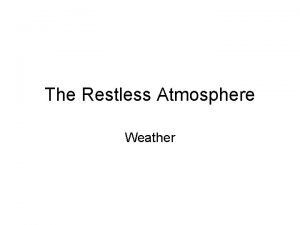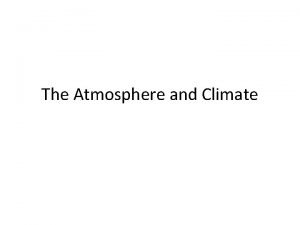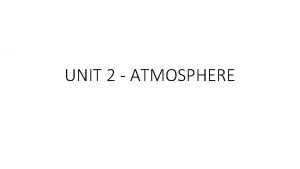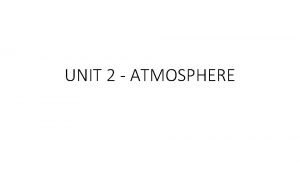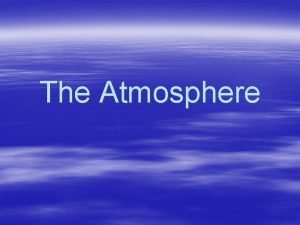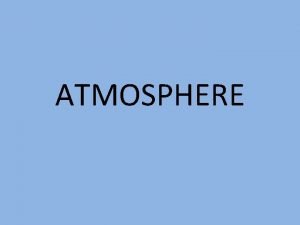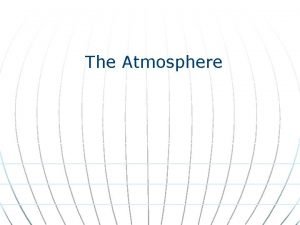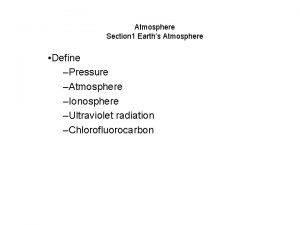Lecture 3 Radiative Transfer Lower Solar Atmosphere has







































- Slides: 39

Lecture 3 Radiative Transfer

• Lower Solar Atmosphere has two layers: – Photosphere - 100 km thick; opaque – Chromosphere - 10, 000 km thick; optically thin; cooler

• (I) Local Thermodynamic Equilibrium – Equation of Transfer: • Optical Depth


– Thermodynamic Equilibrium • A single value of temperature T is sufficient to describe thermodynamic state everywhere • state of excitation is governed by Boltzman equation • state of ionization is governed by Saha equation • radiation field is homogeneous and isotropic black body

– Local Thermodynamic Equilibrium (LTE) Above conditions are satisfied in a local area. Such conditions are usually satisfied in the continuum of visible and near infrared, and wings of most spectral lines

– Absorption lines in LTE


The key is to find two quantum mechanics quantities , in the expression of a, damping constant and f, the oscillator strength in addition Doppler width is modified in the existence of turbulence velocity

– Non-LTE: Statistical Equilibrium Temperature is now defined as electron temperature, Te , velocity distribution is still Maxwellian, because of frequent collision.

– Einstein Coefficients Considering a line radiation between two energy levels EL (lower) and EU (upper), h = EU- EL • Spontaneous emission from upper to lower energy n. U AUL ( )/4 number of emissions per unit time, volume, frequency interval and solid angle. n. U : number of atoms in upper level/volume; ( ): frequency distribution of emitted photon; AUL: Einstein coefficient for spontaneous emission (It’s dimension is 1/time; 108 s-1 is typical. )

• Induced Emission and Absorption n. U BULI ( )/4 emission n. U BLUI ( )/4 absorption I : radiation intensity; ( ): line profile; BUL and BLU : Einstein coefficient of induced emission and absorption. B, I have the same unit as A.

– Continuum Radiation • Photoionization Number of photoionizations from level j, unit time, volume, frequency interval and solid angle: • Radiative Recombination

– Collision collision transition rate: Cij, which has no direct influence on radiation field, could be for line transition or continuum transition.

– Source Function Radiative Transfer:



– Equations of Statistical Equilibrium

– Limb Darkening (Fig 4. 2, Fig 4. 3)



– Model Calculation of LTE (Fig 4. 4) • Usually, we select =5000 Angstrom as a reference wavelength as it is free of absorption line. For LTE, we have S =B , from B , we derive T( )



– Non-LTE At temperature minimum T=4200 K, 5000=10 -4, LTE model is no longer applicable. Reason is that photo-ionization dominates over radiative recombination, i. e. , neutral population is lower. Figs 4. 7 & 4. 8 give an example for Si. I. Two famous models: • HSRA: Harrard-Smithsonian Reference atmosphere Gingerich et al. (1971) Solar Physics, 18, 347 • VAL model: Vernazza, Avrett and Loeser 1976, Ap. J Supp. 30. 1981, Ap. J Supp. 45, 635


Fig 4. 9, Fig 4. 10 The models here are called semi-empirical as T is adapted in order to reproduce observed intensity I. Table 4. 1 Special Lines: H line D 3 and He I 10830 line Ca. II H and K lines A Simple Atmosphere Model: S is constant =B

Forbidden lines Violates selection rule, so normally the radiative probability is much smaller than the collisional de-excitation, but in the corona, the opposite is true. Resonant Lines (Strong lines, such as H and K) Equivalent Width Integrated Line Intensity Curve of Growth Equivalent Width (W) as a function of number of absorbing atoms (N). It is used to determine abundance and temperature. For weaker lines, W is proportional to N For strong lines, W is proportional to N 1/2









– Chemical Composition Chemical composition can be derived from spectrum analyses - Spectrum Synthesis • Standard Symbol: log A = 12 + log(ni/n. H) ni=1012 particle/unit volume Table 4. 2 • Helium: It was discovered in 1868 by Lockyer. Most accurate determination of Y is from inversion of helium seismology. Y = 0. 248 +/- 0. 002 • Lithium depletion: due to burning of lithium at T=2. 5 10 6 K, t = 5 107 yrs.


HW Set # 3 • Problems 4. 1, 4. 2, 4. 4, 4. 10
 Radiative equilibrium temperature
Radiative equilibrium temperature Radiative equilibrium temperature
Radiative equilibrium temperature Jablonski diagram sequence
Jablonski diagram sequence Radiative equilibrium temperature
Radiative equilibrium temperature Radiative forcing definition
Radiative forcing definition Solar atmosphere
Solar atmosphere Solar energy and the atmosphere
Solar energy and the atmosphere Solar energy and the atmosphere
Solar energy and the atmosphere Lesson 2 energy transfer in the atmosphere
Lesson 2 energy transfer in the atmosphere 01:640:244 lecture notes - lecture 15: plat, idah, farad
01:640:244 lecture notes - lecture 15: plat, idah, farad Wholesale panel solar cell
Wholesale panel solar cell Inexhaustible source of energy
Inexhaustible source of energy Very thin atmosphere
Very thin atmosphere Transfer transfer
Transfer transfer Solar radiation has a part in the water cycle by
Solar radiation has a part in the water cycle by Frank has an eraser it has a mass of 4g
Frank has an eraser it has a mass of 4g A problem has been
A problem has been Windows a problem has been detected
Windows a problem has been detected Spring has sprung the grass is riz
Spring has sprung the grass is riz Every picture has a story and every story has a moment
Every picture has a story and every story has a moment He who has ears to hear
He who has ears to hear Temporary behavior of atmosphere
Temporary behavior of atmosphere Troposphere characteristics
Troposphere characteristics The atmosphere protects earth from
The atmosphere protects earth from Hottest layer of atmosphere
Hottest layer of atmosphere Edible aquifer lab activity answers
Edible aquifer lab activity answers Schiaparelli
Schiaparelli Extends high earth atmosphere
Extends high earth atmosphere The outermost layer of atmosphere
The outermost layer of atmosphere Earth atmosphere composition
Earth atmosphere composition Hydrosphere lithosphere atmosphere
Hydrosphere lithosphere atmosphere The atmosphere is a mixture of ___________.
The atmosphere is a mixture of ___________. Characteristics of the atmosphere
Characteristics of the atmosphere Atmosphere ideas
Atmosphere ideas This is a violent disturbance in the atmosphere
This is a violent disturbance in the atmosphere Furnace atmosphere control
Furnace atmosphere control Convective rain
Convective rain Earth atmosphere ppt
Earth atmosphere ppt Percent of oxygen in the atmosphere
Percent of oxygen in the atmosphere Outline of photosynthesis
Outline of photosynthesis
